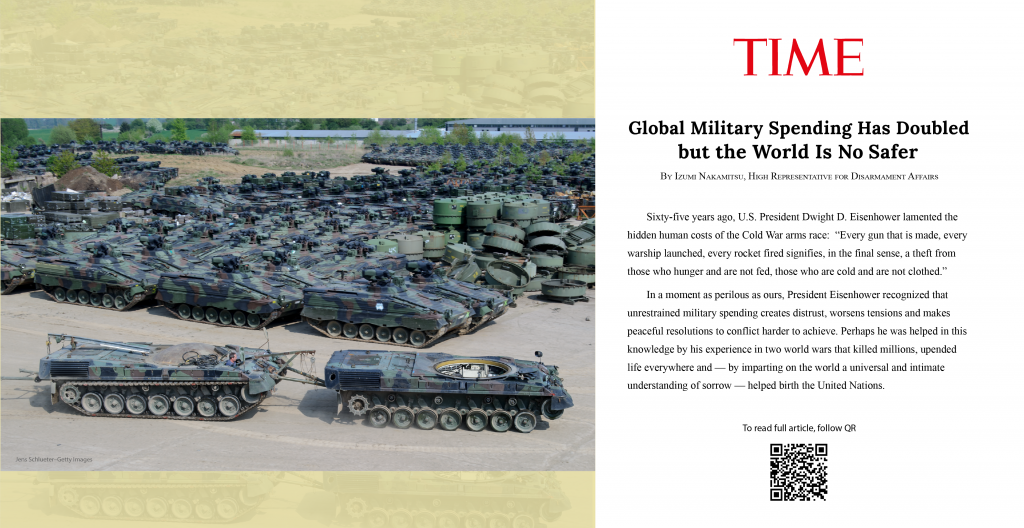According to the Stockholm International Peace Research Institute (SIPRI), the world’s military expenditure for 2018 was $ 1822 billion, the highest figure reported since the end of the Cold War. It also means 83 billion more than in 2017, passing from a 1.1% to a 2.6% increase in real terms. This trend of militarizing and stockpiling weapons is led by the USA, a country which has increased its military spending to $649 billion, 4,6% more than in the previous year, remaining thus by far the largest spender in the world and accounting for 36% of global military budget in 2018. The US and its NATO allies account, once again, for more than half of all military spending in the world, having reached $ 963 billion.
The European Union is the second largest military spender accounting for 15% of the global military spending, above China, which has also increased its expenditure by 5% to $250 billion. China is followed in SIPRI’s ranking by Saudi Arabia, India, France, Russia, the UK, Japan and South Korea.
The 10 biggest spenders account for almost three quarters of the world’s total.
The amount of money spent on the military sector in 2018 equals $4.9 billion a day or $235 per person.
Militarization is accelerating at an alarming rate at a time when it should be drastically reduced in order to tackle the grave challenges humanity is facing. The world therefore diverts huge amounts of resources to the military sector, leaving basic needs such as food, health, education, employment and environmental challenges greatly under-funded. The imbalance between defence and social or development aid budgets is striking in most countries. Yet despite the global economic crisis and a general public opinion opposed to war and militarization, there are few real signs that governments are at this point ready to initiate a radical shift in spending priorities.
The global military spending accounts for 2,1 % of global GDP, an amount which could instead be used to alleviate human suffering and realise comprehensive programmes such as the UN Sustainable Development Goals. According to the SIPRI the reduction of only the 10% of military spending would be enough to achieve major progress on some key SDGs, supposing that such funds could be effectively channeled towards these goals.
The Global Commission on Adaptation to climate change calculated in a report that an investment of $1.8 trillion (€1.6 trillion) across five key areas (early warning systems; climate-resilient infrastructure; improved dryland agriculture; mangrove protection; water resources resilience) over the next decade would yield a return of $7.1 trillion in economic benefits.
$1.8 trillion is exactly what the world spent in the military only in 2018.
According to SIPRI, military expenditure includes spending on ‘defence ministries and other government agencies engaged in defence projects; paramilitary forces when judged to be trained, equipped and available for military operations and military space activities’.
The expenditures include:
– All expenditures on current personnel, military and civil
– Retirement pensions of military personnel
– Social services for personnel and their families
– Operations and maintenance
– Procurement
– Military research and development
– Military construction
– Military aid (in the military expenditures of the donor country).
For reasons of comparability between states, SIPRI data on military spending does not include civil defence, current expenditure for previous military activities, veterans’ benefits, demobilization, conversion of arms production facilities or destruction of weapons.
The omission of such data means that large sums are not taken into account. In the USA, the costs of veterans’ benefits and the military share of interest on the national debt amount to 18% of government spending. We can conclude that the true overall costs of the military
worldwide must be substantially higher than those often referenced.
However, without detailed reporting on these additional costs in each country a complete global tally is impossible.
For More Information:
- IPB’s publications:
Opportunity Costs: Military Spending and the UN Development Agenda
Whose priorities? A guide for campaigners on military and social spending
Warfare or Welfare? - The Stockholm International Peace Research Institute (SIPRI)
- The United Nations Report on Military Spending
- Disarmament – A Basic Guide (see chapter 2 on Global Military Expenditures)
- United Nations Office for Disarmament Affairs (UNODA)


